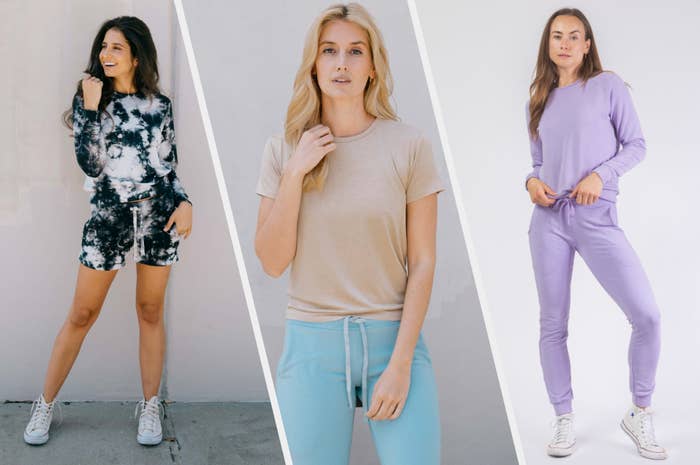What Makes Branded Clothing Ideal for Sensitive Skin?
Wiki Article
The Significance of Lasting Clothes: Just How It Impacts the Environment and Your Storage room
Sustainable clothing is progressively recognized for its important duty in lessening the ecological effect of the rapid fashion business. By concentrating on eco-friendly materials and honest manufacturing techniques, it resolves pressing ecological worries. This change not just profits the planet however likewise affects consumer choices, bring about a more thoughtful approach to closet management. Comprehending these dynamics raises important concerns concerning style's future and individual responsibility fit it.The Ecological Impact of Fast Fashion

Advantages of Sustainable Materials
Lasting products supply substantial benefits, specifically through environment-friendly textile choices that reduce environmental harm. These materials also demonstrate sturdiness and durability, minimizing the requirement for regular substitutes. Because of this, they add to a more lasting fashion sector and promote accountable customer habits.Eco-Friendly Textile Selections
While the fashion business has long been connected with rapid fads and ecological damage, the rise of environmentally friendly fabric options presents a transformative opportunity. Lasting products such as natural cotton, hemp, and Tencel have actually gained popularity as a result of their reduced environmental effect. These fabrics are often produced without damaging pesticides and require much less water, minimizing their carbon footprint - Branded Clothing. Additionally, many environment-friendly textiles are eco-friendly, adding to a round economic situation by decreasing waste. Picking lasting products not only supports eco liable practices yet also advertises much healthier environments. As consumers come to be extra knowledgeable about their buying power, the need for eco-friendly textiles motivates brand names to introduce and take on even more sustainable manufacturing techniques, inevitably benefiting the planet and future generations
Toughness and Long Life Benefits
Lots of consumers are significantly identifying the longevity and durability benefits of sustainable materials in their clothing options. Unlike conventional materials, lasting materials such as natural cotton, hemp, and recycled polyester are engineered to hold up against damage, leading to garments that last longer. This lowered regularity of replacement not only saves consumers money over time yet additionally diminishes waste created by quick fashion. Furthermore, sustainable garments frequently utilizes eco-friendly manufacturing approaches that enhance fabric toughness, adding to a reduction in the total carbon impact. By purchasing sturdy apparel, customers can grow a more sustainable wardrobe while taking pleasure in top notch pieces that preserve their aesthetic and performance gradually. Toughness and durability stand as key benefits of selecting sustainable materials.Lowering Waste Through Lasting Practices
Lowering waste in the fashion business can be achieved through cutting-edge methods such as upcycling and repurposing products. Additionally, embracing minimal wardrobe methods encourages consumers to focus on quality over quantity, inevitably reducing garments intake. With each other, these methods contribute greatly to a more sustainable clothing design.Upcycling and Repurposing Products
Upcycling and repurposing products have become ingenious methods in the fashion business, changing thrown out fabrics into beneficial brand-new items. This approach not just minimizes waste yet also encourages imagination and individuality in apparel style. By taking old garments and materials, developers can develop one-of-a-kind pieces that show personal style while lowering the need for new sources. Furthermore, upcycling frequently requires less power and water compared to conventional manufacturing processes, greatly lowering the environmental impact of fashion. As customers come to be much more aware of sustainability, the appeal of upcycled apparel remains to increase, promoting a round economic climate. Eventually, these practices add to an extra sustainable future, where fashion focuses on environmental health and wellness over fast production and consumption.
Minimal Closet Strategies
As individuals significantly look for to decrease their environmental effect, embracing minimal closet methods has actually obtained grip as a reliable method to sustainable fashion. These methods stress high quality over amount, motivating customers to curate a smaller collection of flexible, durable garments. By focusing on timeless why not check here items that can be mixed and matched, people can reduce the regularity of acquisitions and inevitably reduce waste.Additionally, minimalism advertises conscious usage, prompting customers to show on the ethical and environmental ramifications of their options. This approach not only cultivates a more lasting way of living however also streamlines everyday decision-making concerning outfit. As people embrace minimalist principles, they add to a style society that values sustainability and liable consumerism, ultimately resulting in a much more eco-conscious culture.The Role of Ethical Labor in Lasting Style
While lots of customers are increasingly familiar with the environmental effects of their clothes selections, the significance of honest labor practices in lasting style can not be forgotten. Ethical labor encompasses reasonable incomes, secure working problems, and respect for workers' legal rights, creating the foundation of responsible style production. Brands that focus on ethical labor not just boost areas yet also established a criterion for responsibility in the industry.Moreover, the combination of honest methods fosters openness, allowing consumers to make educated selections about their purchases. This practice contrasts sharply with quick fashion's exploitative labor versions, which typically focus on earnings over people. By supporting firms committed to ethical labor, customers add to a system that values human self-respect alongside environmental sustainability. Ethical labor is not merely an add-on; it is vital to the more comprehensive mission of lasting fashion, making certain that the quest for eco-friendliness does not come at the expense of human rights.The Impact of Lasting Clothes on Carbon Emissions
Sustainable clothing has the prospective to significantly lower carbon exhausts related to the fashion business. Conventional garment production contributes notably to greenhouse gas exhausts, primarily due to energy-intensive manufacturing procedures and making use of non-renewable sources. On the other hand, sustainable style concentrates on environmentally friendly materials, such as organic cotton or recycled fibers, which typically call for less power to produce.Moreover, sustainable brands have a tendency to adopt much more reliable manufacturing practices, minimizing waste and decreasing overall exhausts. By focusing on resilience and classic style, lasting clothing encourages consumers to get less regularly, additional reducing the carbon footprint connected with overconsumption.Additionally, numerous sustainable brands are devoted to openness in their supply chains, allowing customers to make enlightened choices that align with their worths. Inevitably, shifting in the direction of sustainable apparel can lead to a substantial reduction in carbon exhausts, contributing to a much healthier earth and a more lasting future for the style sector.Supporting Neighborhood Economic Situations With Sustainable Selections
The shift towards sustainable apparel not only addresses ecological problems however additionally substantially benefits regional economic situations. By selecting lasting style, consumers commonly support little services and local artisans, improving neighborhood resilience. These business generally operate a smaller sized scale, prioritizing workmanship and moral methods over mass production.Investing in locally made lasting clothes cultivates work development and promotes financial growth within communities. As consumers come to be much more familiar with the environmental effect of their acquisitions, they increasingly look for items that show their values. This demand encourages regional producers to embrace lasting techniques, contributing to a circular economy.Moreover, supporting local services minimizes transport exhausts, straightening with eco-conscious consumer habits. The interconnectedness of sustainable apparel and neighborhood economic climates underscores the essential role that specific selections play in promoting both financial and environmental health. By promoting these regional connections, communities can grow while also functioning in the direction of a much more lasting future.Transforming Your Closet: Tips for a Sustainable Wardrobe
As people seek to reduce their environmental influence, transforming a wardrobe into a lasting wardrobe becomes an essential step. One effective technique is to examine existing clothing, keeping only things that are used routinely and that align with sustainability objectives. Prioritizing top quality over amount is crucial; spending in resilient pieces from environmentally friendly brand names can substantially reduce waste.Additionally, incorporating used items can rejuvenate a closet while discover this minimizing ecological damage. Organizing garments swaps with buddies or donating unused products can even more advertise sustainability.When purchasing, individuals need to seek materials that are organic, recycled, or eco-friendly, and prevent quick style stores - Branded Clothing. Lastly, practicing conscious intake by attentively thinking about each acquisition can contribute to a more lasting way of life. By implementing these suggestions, one can develop a closet that shows personal style while supporting environmental stewardshipFrequently Asked Inquiries
Exactly How Can I Determine Lasting Garments Brands?
To recognize lasting apparel brand names, one need to research products used, examine for accreditations like Fair Profession, and analyze the brand's transparency about their manufacturing processes, labor methods, and environmental effect, making certain environmentally friendly and honest practices are prioritized.What Are the Prices Related To Sustainable Fashion?
The costs linked with lasting style can vary considerably. Higher production expenditures, ethical sourcing, and environment-friendly products usually result in raised retail costs, which might discourage some consumers view website while interesting environmentally mindful customers.Can Lasting Garments Be Trendy and stylish?
Sustainable clothing can indeed be stylish and trendy. Developers increasingly focus on ingenious products and ethical manufacturing approaches, showing that style and sustainability can exist together. Customers now have diverse alternatives that blend aesthetic appeals with environmental consciousness.Just How Does Laundering Garments Affect Their Sustainability?
Cleaning clothes significantly impacts sustainability by consuming water and energy, adding to air pollution, and triggering microplastic launch. Constant washing can degrade materials, shortening their life-span and enhancing the need for replacements, ultimately worsening environmental worries.What Is the Life-span of Sustainable Clothes Contrasted to Quick Fashion?
The lifespan of lasting apparel normally goes beyond that of fast style things, typically lasting a number of years due to quality materials and craftsmanship. In comparison, rapid fashion garments might deteriorate promptly, demanding more constant substitutes. Lasting garments is significantly identified for its essential function in decreasing the environmental impact of the quick style sector. While many consumers are significantly conscious of the environmental effects of their clothes choices, the importance of moral labor techniques in lasting fashion can not be neglected. Branded Clothing. Sustainable garments has the possible to greatly reduce carbon discharges associated with the style sector. In comparison, lasting style focuses on environment-friendly products, such as natural cotton or recycled fibers, which commonly require less power to produce.Moreover, lasting brand names tend to adopt much more efficient production techniques, minimizing waste and reducing total emissions. By prioritizing resilience and ageless layout, sustainable garments encourages customers to buy less regularly, further lowering the carbon impact linked with overconsumption.Additionally, numerous sustainable brand names are committed to openness in their supply chains, allowing consumers to make educated choices that straighten with their valuesReport this wiki page